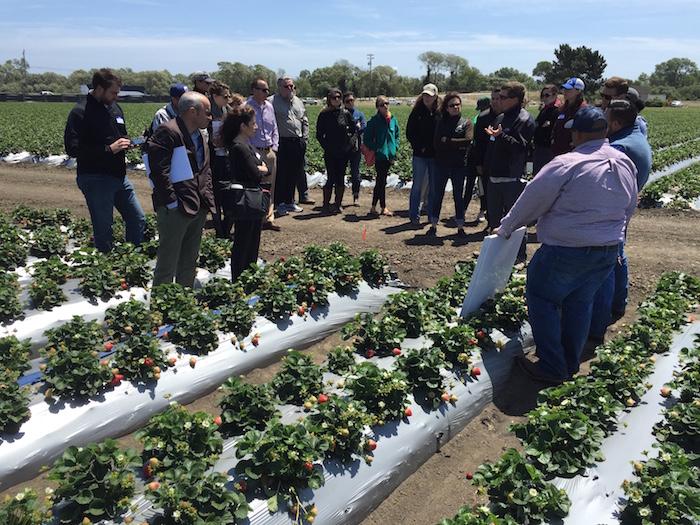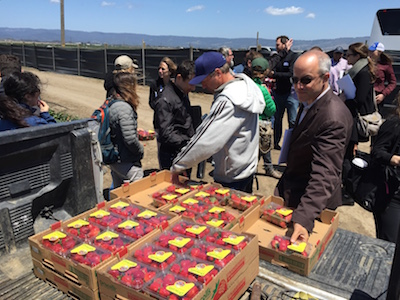

|
From Farm to Table
Did you head to the grocery store this past weekend to stock your fridge and pantry for the week ahead? Were there favorite products you gravitated towards? Many of our favorite brands are made from some of California’s more than 350 crop varieties.
The food we love is at the center of an inter-dependent relationship between consumers, food and beverage companies, and the farmers and ranchers who produce it. And the truth is, it takes a lot of water to grow crops and raise livestock.
Unfortunately, finger pointing has dominated the water conversation; but blaming does nothing to address the challenges California faces in finding a water balance that best works for the Golden State’s communities, agriculture, business and environment.
What if we took a different approach and asked what roles each of these groups can play? From farmers to global brands, how can we find common ground and innovative solutions that will help California solve its tough water challenges?

Pictured (from right to left) Daniel Mountjoy (Sustainable Conservation), Kelli McCune (Sustainable Conservation), Brooke Barton (Ceres), and Eliza Roberts (Ceres). |
Out of the Boardroom, into the Field
This past month, Sustainable Conservation teamed up with Ceres to bring representatives from global food brands and socially responsible investment firms out of the boardrooms and onto the farm to consider these very questions.
Ceres, which mobilizes networks of investors and publicly traded companies to accelerate and expand the adoption of sustainable business practices and strategies, launched a policy campaign in California this year. The effort, called Connect the Drops, encourages business to advocate for policies that ensure a sustainable water supply and healthy economy.
We’re excited to be working with Ceres because we share a very important common objective: ensuring that companies with material water risks in California play an active role in identifying solutions for more sustainable water management. We each bring a unique expertise and set of relationships that are complementary – and the partnership is an effort to support each other’s programmatic activities as we further our common goal.
During the ‘Growing Food While Saving Water on California’s Central Coast’ tour, Sustainable Conservation showcased our work in the Pajaro Valley, done in conjunction with our partners, Driscoll’s Berries and the Resource Conservation District of Santa Cruz County (RCD).
The attendees heard from a Driscoll’s strawberry grower about the realities of crop production and what is needed to better manage water, such as efforts to measure irrigation water use in real-time. The berry field stop was followed by a lunch panel discussion with Driscoll’s, the RCD, the Pajaro Valley Water Management Agency (PVWMA), another berry farmer, and Sustainable Conservation.

A group shot of the event participants and project partners that came together to discuss water challenges and solutions. |
Falling into Place: A Convergence of Roles
Corporate representatives and investors learned about Driscoll’s leadership and its call for everyone to get involved in a different, more positive conversation. Driscoll’s emphasized farming’s dependence on the region’s water supply, while also underscoring that continued viability needs constructive, multi-level stakeholder engagement.
This thinking helped catalyze the Community Water Dialogue, which empowers all local water users to collectively think through and develop solutions to the region’s water challenges. As the lead government agency responsible for addressing groundwater overdraft, PVWMA shared their robust science and planning expertise, while the RCD showcased its facilitation and technical assistance skill sets.
Take a virtual #growers field trip of CA Central Coast w/ @CeresNews @SusCon_CA #H2O management http://t.co/kmc9mRXOL0 pic.twitter.com/jBCRgerdau
— Value Every Drop (@valueeverydrop) June 4, 2015
These roles are essential, and will only become more so, in the quest to promote sound decision-making and foster open and respectful dialogue between all those who rely on the region’s water supply. In telling their stories, the panelists also illuminated possible roles that companies can play in the regions in which they source crops.
The roles, which range from supporting sustainable water management at the farm level to promoting discourse beyond boardrooms, are also integral in connecting farmers, community members, government agencies, environmental groups and businesses. The collective thinking that can result from these groups coming together can be a powerful force to propel forward regional solutions that achieve water balance for all.
Sustainable Conservation is proud to work with these partners in the Pajaro Valley, and we have expanded our efforts to the neighboring Salinas Valley, where similar water challenges call for collaboration and new ideas. Check back in the coming weeks for more information on this work and learn more about our work in the Pajaro Valley here.
